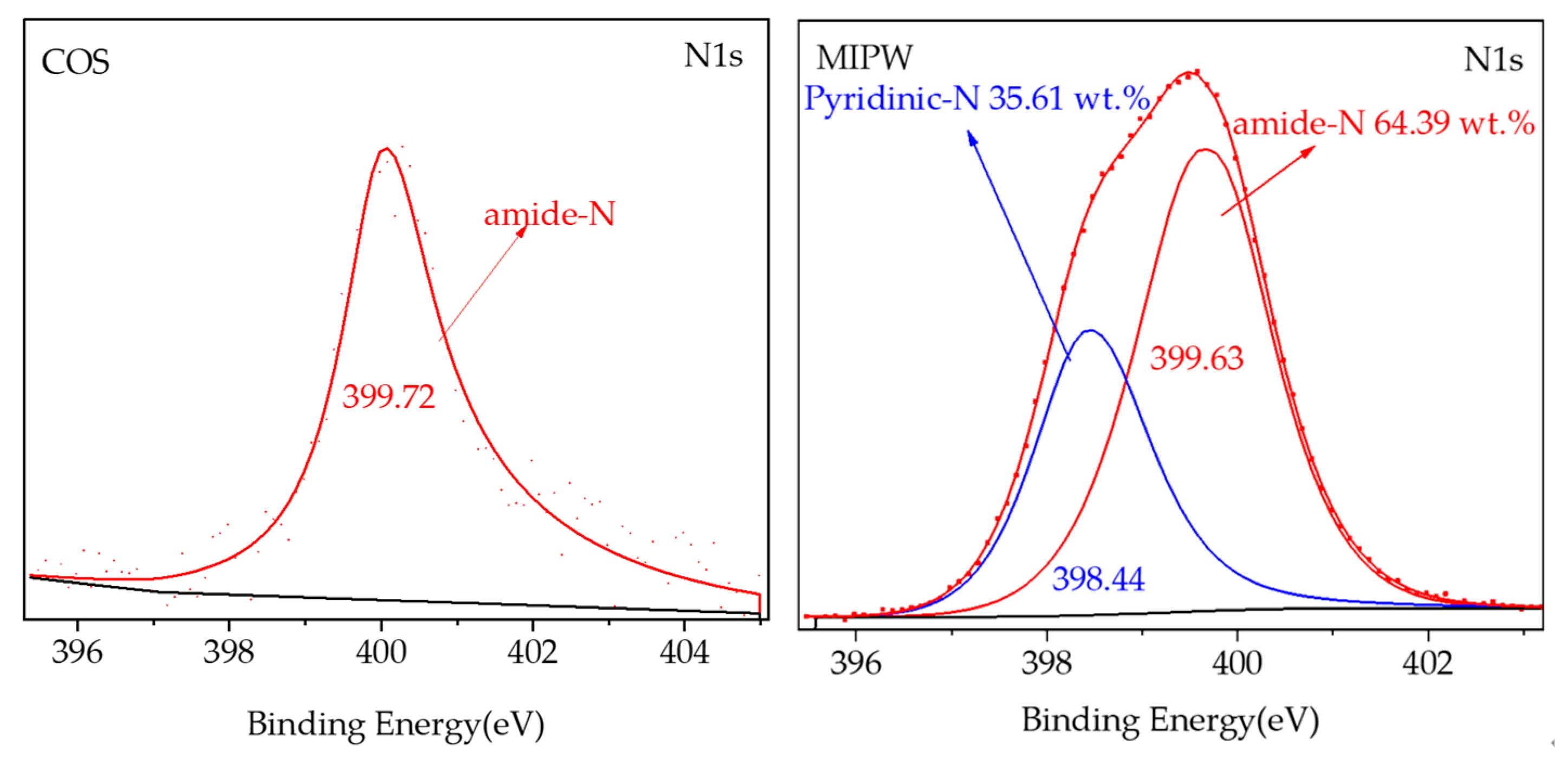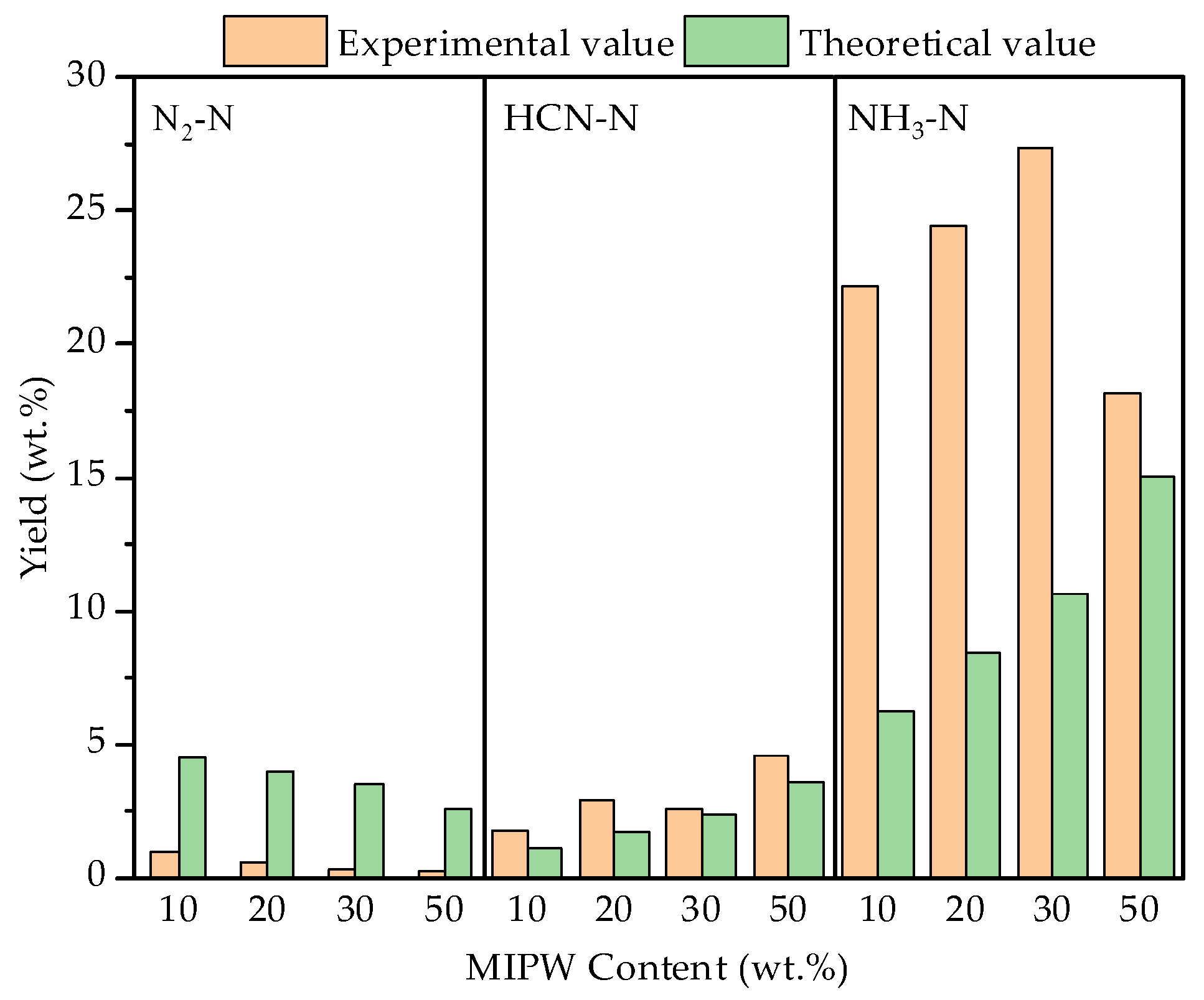Study on Nitrogen Migration during Co-Pyrolysis of Melamine-Impregnated Paper Waste and Camellia Oleifera Shell
Abstract
1. Introduction
2. Materials and Methods
2.1. Experimental Raw Materials and Reagents
2.2. Experimental Equipment and Pyrolysis Steps
2.3. Calculation of Yield of Pyrolysis Products
2.4. N-Containing Components and Their Determination Methods
3. Results and Discussion
3.1. Thermogravimetric Analysis of Raw Materials
3.2. XPS Analysis of Raw Materials
3.3. Pyrolysis Product Distribution
3.4. N in Biochar
3.4.1. Elemental Analysis of Biochar
3.4.2. XPS Analysis of Biochar
3.4.3. N-Containing Functional Groups in the Gas Phase
3.4.4. N-Containing Components in the Liquid Phase
3.4.5. N Balance
4. Conclusions
Author Contributions
Funding
Institutional Review Board Statement
Informed Consent Statement
Data Availability Statement
Conflicts of Interest
References
- Zhu, X.; Lu, Q. Principles and Technologies of Biomass Pyrolysis; University of Science and Technology of China Press: Hefei, China, 2006. (In Chinese) [Google Scholar]
- Chen, X.Y.; Chen, C.; Zhang, Z.J.; Xie, D.H.; Deng, X.; Liu, J.W. Nitrogen-doped porous carbon for supercapacitor with long-term electrochemical stability. J. Power Sources 2013, 230, 50–58. [Google Scholar] [CrossRef]
- Cheng, T.; Bian, Y.; Li, J.; Ma, X.; Yang, L.; Zhou, L.; Wu, H. Nitrogen-doped porous biochar for selective adsorption of toluene under humid conditions. Fuel 2023, 334, 126452. [Google Scholar] [CrossRef]
- Yu, B.; Man, Y.; Wang, P.; Wu, C.; Xie, J.; Wang, W.; Jiang, H.; Zhang, L.; Zhang, Y.; Mao, L.; et al. Catalytic degradation of dimethomorph by nitrogen-doped rice husk biochar. Ecotoxicol. Environ. Saf. 2023, 257, 114908. [Google Scholar] [CrossRef]
- Zhang, X.; Wu, J.; Yang, H.; Shao, J.; Wang, X.; Chen, Y.; Zhang, S.; Chen, H. Preparation of nitrogen-doped microporous modified biochar by high temperature CO2–NH3 treatment for CO2 adsorption: Effects of temperature. RSC Adv. 2016, 6, 98157–98166. [Google Scholar] [CrossRef]
- Zhong, Y.; He, J.; Duan, S.; Cai, Q.; Pan, X.; Zou, X.; Zhang, P.; Zhang, J. Revealing the mechanism of novel nitrogen-doped biochar supported magnetite (NBM) enhancing anaerobic digestion of waste-activated sludge by sludge characteristics. J. Environ. Manag. 2023, 340, 117982. [Google Scholar] [CrossRef]
- Ma, L.L.; Hu, X.; Liu, W.J.; Li, H.C.; Lam, P.K.; Zeng, R.J.; Yu, H.Q. Constructing N, P-dually doped biochar materials from biomass wastes for high-performance bifunctional oxygen electrocatalysts. Chemosphere 2021, 278, 130508. [Google Scholar] [CrossRef] [PubMed]
- Xu, L.; Fu, B.; Sun, Y.; Jin, P.; Bai, X.; Jin, X.; Shi, X.; Wang, Y.; Nie, S. Degradation of organic pollutants by Fe/N co-doped biochar via peroxymonosulfate activation: Synthesis, performance, mechanism and its potential for practical application. Chem. Eng. J. 2020, 400, 125870. [Google Scholar] [CrossRef]
- Lan, C. Experimental Study on Producing Particleboard by Using Waste Impregnated Paper. China For. Prod. Ind. 2016, 43, 6–9. (In Chinese) [Google Scholar]
- Zhang, Y.; Lin, X.; Hu, C.; Yun, H. Activated carbon from melamine-impregnated paper. BioResources 2023, 18, 1128. [Google Scholar] [CrossRef]
- Peng, J.; Liao, D.; Yan, C.; Yang, F.; Zhang, P.; Du, G.; Zhou, X. Effect of zinc chloride on the properties of tannin-urea-formaldehyde (TUF) co-polycondensation resins. J. Northwest For. Univ. 2023, 38, 228–234. [Google Scholar]
- Samaržija-Jovanović, S.; Jovanović, V.; Konstantinović, S.; Marković, G.; Marinović-Cincović, M. Thermal behavior of modified urea–formaldehyde resins. J. Therm. Anal. Calorim. 2011, 104, 1159–1166. [Google Scholar] [CrossRef]
- Yang, Z.; Fu, L.; Fan, F. Thermal Characteristics and Kinetics of Waste Camellia oleifera Shells by TG–GC/MS. ACS Omega 2019, 4, 10370–10375. [Google Scholar] [CrossRef]
- Zhan, H.; Zhuang, X.; Song, Y.; Yin, X.; Cao, J.; Shen, Z.; Wu, C. Step pyrolysis of n-rich industrial biowastes: Regulatory mechanism of no x precursor formation via exploring decisive reaction pathways. Chem. Eng. J. 2018, 344, 320–331. [Google Scholar] [CrossRef]
- Li, X.; Zhang, P.; Huang, H.; Zhai, X.; Chen, B.; He, Y.; Guo, Z. Etched Carbon Fiber/Polyaniline Composite with p–n Heterojunction for High-Energy Electrochemical Supercapacitor. ECS J. Solid State Sci. Technol. 2021, 10, 013005. [Google Scholar] [CrossRef]
- Yu, D.L.; He, J.L.; Liu, Z.Y.; Xu, B.; Li, D.C.; Tian, Y.J. Phase transformation of melamine at high pressure and temperature. J. Mater. Sci. 2008, 43, 689–695. [Google Scholar] [CrossRef]
- Chen, Q.; Dong, Z.; Zhang, C.; Yue, Y.; Xu, Q. Variation behavior of organic compounds in melamine-urea-formaldehyde impregnated bond paper in different pyrolysis stages. J. Hazard. Mater. 2022, 436, 129237. [Google Scholar] [CrossRef]
- Wan, Z.; Sun, Y.; Tsang, D.C.; Khan, E.; Yip, A.C.; Ng, Y.H.; Rinklebe, J.; Ok, Y.S. Customised fabrication of nitrogen-doped biochar for environmental and energy applications. Chem. Eng. J. 2020, 401, 126136. [Google Scholar] [CrossRef]
- Grimm, A.; dos Reis, G.S.; Khokarale, S.G.; Ekman, S.; Lima, E.C.; Xiong, S.; Hultberg, M. Shiitake spent mushroom substrate as a sustainable feedstock for develop highly efficient nitrogen-doped biochar for treatment of dye-contaminated water. J. Water Process Eng. 2023, 56, 104435. [Google Scholar] [CrossRef]
- Zheng, Y.; Li, D.; Wang, J.; Chen, Y.; Liu, C.; Lu, Y.; Lin, X.; Lv, B.; Li, J.; Zheng, Z. Ammonia (NH3)/nitrogen (N2) torrefaction pretreatment of waste biomass for the production of renewable nitrogen-containing chemicals via catalytic ammonization pyrolysis: Evolution of fuel-N under a N2/NH3-rich atmosphere. J. Energy Inst. 2022, 102, 143–159. [Google Scholar] [CrossRef]
- Wang, Z.; Zhang, J.; Zhao, Y.; Li, Y.; Zheng, C. Release characteristics of NO, NH3 and HCN during biomass pyrolysis. J. Fuel Chem. Technol. 2011, 39, 99–102. (In Chinese) [Google Scholar]
- Zhan, H.; Yin, X.; Huang, Y.; Yuan, H.; Wu, C. NOx precursors evolving during rapid pyrolysis of lignocellulosic industrial biomass wastes. Fuel 2017, 207, 438–448. [Google Scholar] [CrossRef]
- Anca-Couce, A.; Sommersacher, P.; Evic, N.; Mehrabian, R.; Scharler, R. Experiments and modelling of NOX precursors release (NH3 and HCN) in fixed-bed biomass combustion conditions. Fuel 2018, 222, 529–537. [Google Scholar] [CrossRef]
- Wang, X.; Li, C.; You, P.; Liu, X.; Wang, Y. Migration and transformation of nitrogen during sludge hydrothermal treatment. Chin. J. Chem. Eng. 2018, 69, 2688–2696. (In Chinese) [Google Scholar]









| Sample | Industrial Analysis wt.% | Elemental Analysis wt.% | |||||||
|---|---|---|---|---|---|---|---|---|---|
| Mad | Ad | Vdaf | FCdaf | Cdaf | Hdaf | Ndaf | Sdaf | Odaf a | |
| COS | 8.19 | 3.88 | 75.68 | 24.32 | 48.35 | 4.30 | 0.77 | 0.06 | 46.52 |
| MIPW | 5.79 | 15.31 | 84.34 | 15.67 | 39.76 | 5.40 | 26.08 | 0.22 | 28.54 |
| Experiment | NA (wt.%) | NT (wt.%) | NA − NT (wt.%) |
|---|---|---|---|
| COS | 1.45 | - | - |
| CM-10 | 3.01 | 3.21 | −0.20 |
| CM-20 | 4.16 | 4.97 | −0.81 |
| CM-30 | 5.62 | 6.73 | −1.01 |
| CM-50 | 9.63 | 10.25 | −0.62 |
| MIPW | 19.05 | - | - |
| Experiment | Gas Phase | Liquid Phase | Solid Phase | |||||
|---|---|---|---|---|---|---|---|---|
| NH3-N | HCN-N | N2-N | Total-N | NH3-N | Organic-N | Total-N | Total-N | |
| COS | 4.01 | 0.56 | 5.53 | 9.54 | 23.12 | 7.97 | 31.09 | 58.81 |
| CM-10 | 22.18 | 1.78 | 0.96 | 24.92 | 38.90 | 8.60 | 47.50 | 27.58 |
| CM-20 | 24.39 | 2.93 | 0.60 | 27.92 | 39.86 | 13.63 | 53.49 | 18.59 |
| CM-30 | 27.36 | 2.62 | 0.35 | 30.33 | 41.51 | 12.23 | 52.65 | 17.02 |
| CM-50 | 21.14 | 4.57 | 0.26 | 25.97 | 43.51 | 14.21 | 57.72 | 16.31 |
| MIPW | 26.06 | 6.61 | 0.15 | 32.82 | 40.88 | 10.62 | 51.00 | 16.18 |
Disclaimer/Publisher’s Note: The statements, opinions and data contained in all publications are solely those of the individual author(s) and contributor(s) and not of MDPI and/or the editor(s). MDPI and/or the editor(s) disclaim responsibility for any injury to people or property resulting from any ideas, methods, instructions or products referred to in the content. |
© 2024 by the authors. Licensee MDPI, Basel, Switzerland. This article is an open access article distributed under the terms and conditions of the Creative Commons Attribution (CC BY) license (https://creativecommons.org/licenses/by/4.0/).
Share and Cite
Zhuo, Z.; Li, Y.; Liu, P.; Sun, T.; Lei, T. Study on Nitrogen Migration during Co-Pyrolysis of Melamine-Impregnated Paper Waste and Camellia Oleifera Shell. Sustainability 2024, 16, 1197. https://doi.org/10.3390/su16031197
Zhuo Z, Li Y, Liu P, Sun T, Lei T. Study on Nitrogen Migration during Co-Pyrolysis of Melamine-Impregnated Paper Waste and Camellia Oleifera Shell. Sustainability. 2024; 16(3):1197. https://doi.org/10.3390/su16031197
Chicago/Turabian StyleZhuo, Zhen, Yanling Li, Peng Liu, Tanglei Sun, and Tingzhou Lei. 2024. "Study on Nitrogen Migration during Co-Pyrolysis of Melamine-Impregnated Paper Waste and Camellia Oleifera Shell" Sustainability 16, no. 3: 1197. https://doi.org/10.3390/su16031197
APA StyleZhuo, Z., Li, Y., Liu, P., Sun, T., & Lei, T. (2024). Study on Nitrogen Migration during Co-Pyrolysis of Melamine-Impregnated Paper Waste and Camellia Oleifera Shell. Sustainability, 16(3), 1197. https://doi.org/10.3390/su16031197






